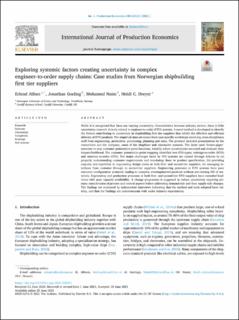| dc.contributor.author | Alfnes, Erlend | |
| dc.contributor.author | Gosling, Jonathan | |
| dc.contributor.author | Naim, Mohamed M | |
| dc.contributor.author | Dreyer, Heidi Carin | |
| dc.date.accessioned | 2022-03-18T09:03:31Z | |
| dc.date.available | 2022-03-18T09:03:31Z | |
| dc.date.created | 2021-12-01T20:11:36Z | |
| dc.date.issued | 2021 | |
| dc.identifier.citation | International Journal of Production Economics. 2021, 240 . | en_US |
| dc.identifier.issn | 0925-5273 | |
| dc.identifier.uri | https://hdl.handle.net/11250/2986076 | |
| dc.description.abstract | While it is recognised that there are varying uncertainty characteristics between industry sectors, there is little uncertainty research directly related to engineer-to-order (ETO) systems. A novel method is developed to identify the factors contributing to uncertainty in shipbuilding first-tier suppliers that inhibit the effective and efficient delivery of ETO products. The empirical data set comes from case-specific workshops involving cross-disciplinary staff from engineering, production, purchasing, planning and sales. The protocol included presentations by the researchers and the company, tours of the shopfloor and interactive sessions. The latter used ‘brown-paper’ exercises to map customer penetration-point locations, identify where uncertainties occurred and evaluate their impact-likelihood. The customer penetration-point mapping identified two ETO types; redesign-to-order (RTO) and innovate-to-order (ITO). The major challenges faced by ITO systems are caused through failures in (a) properly understanding customer requirements and translating those to product specification, (b) providing capacity and capability in engineering design teams at both first- and second-tier suppliers, (c) managing interfaces from customer through to second-tier suppliers. Engineering processes in RTO systems have poor customer configuration protocols leading to complex, overengineered products without pre-existing bill of materials. Engineering and production processes at both first- and second-tier RTO suppliers have extended lead-times with poor capacity availability. A change programme is suggested to reduce uncertainty requiring primary consideration of process and control aspects before addressing demand-side and then supply-side changes. The findings are evaluated by independent interviews indicating that the method and tools adopted have validity, and that the findings are commensurate with wider industry expectations. | en_US |
| dc.language.iso | eng | en_US |
| dc.publisher | Elsevier | en_US |
| dc.rights | Navngivelse 4.0 Internasjonal | * |
| dc.rights.uri | http://creativecommons.org/licenses/by/4.0/deed.no | * |
| dc.title | Exploring systemic factors creating uncertainty in complex engineer-to-order supply chains: Case studies from Norwegian shipbuilding first tier suppliers | en_US |
| dc.type | Peer reviewed | en_US |
| dc.type | Journal article | en_US |
| dc.description.version | publishedVersion | en_US |
| dc.source.pagenumber | 16 | en_US |
| dc.source.volume | 240 | en_US |
| dc.source.journal | International Journal of Production Economics | en_US |
| dc.identifier.doi | 10.1016/j.ijpe.2021.108211 | |
| dc.identifier.cristin | 1963030 | |
| cristin.ispublished | true | |
| cristin.fulltext | original | |
| cristin.qualitycode | 2 | |

